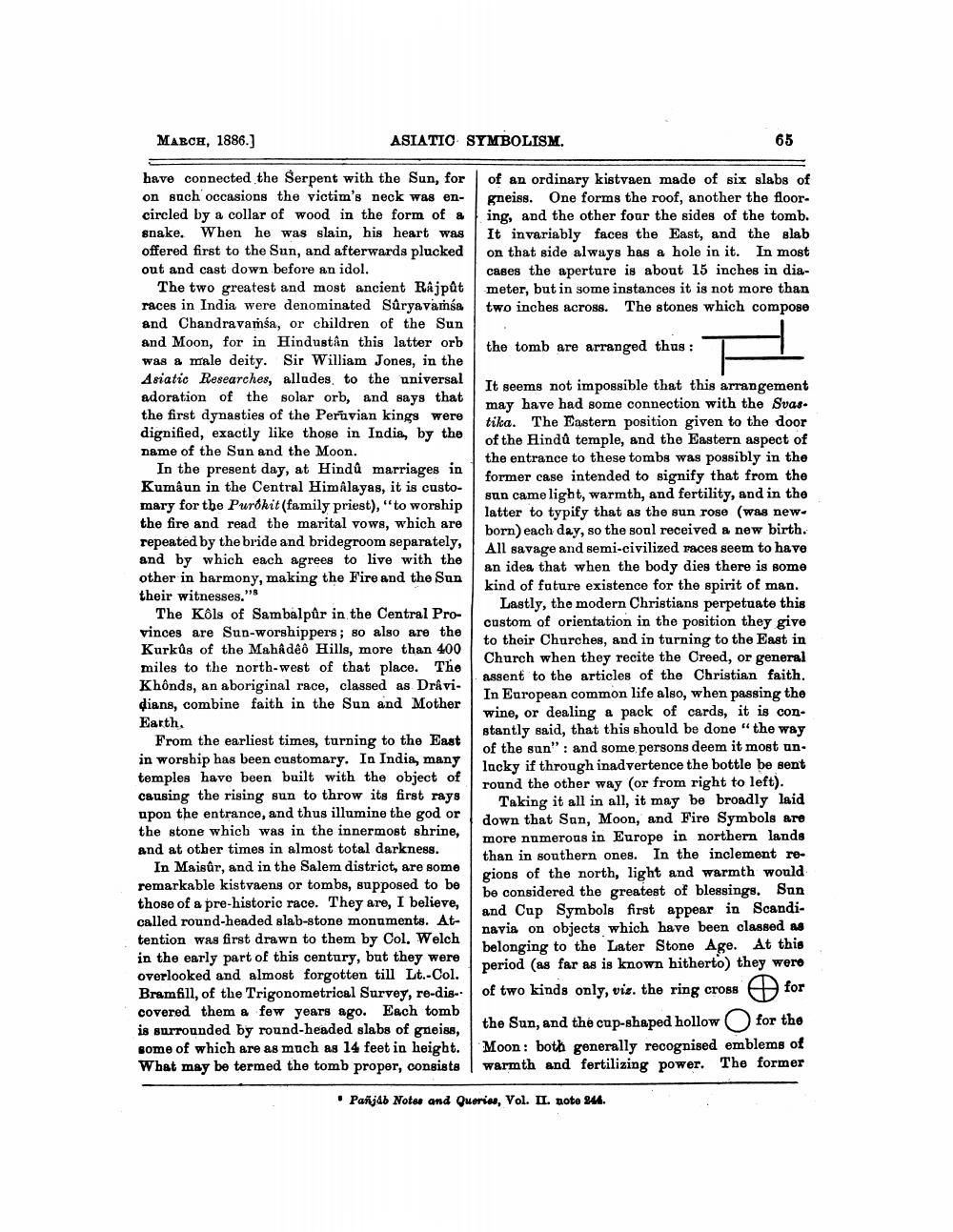________________
MARCH, 1886.)
ASIATIC SYMBOLISM.
65
of an ordinary kistvaen made of six slabs of gneiss. One forms the roof, another the floor. ing, and the other four the sides of the tomb. It invariably faces the East, and the slab on that side always has a hole in it. In most cases the aperture is about 15 inches in diameter, but in some instances it is not more than two inches across. The stones which compose
the tomb are arranged thus :
have connected the Serpent with the Sun, for on such occasions the victim's neck was en- circled by a collar of wood in the form of a snake. When he was slain, his heart was offered first to the Sun, and afterwards plucked out and cast down before an idol.
The two greatest and most ancient Rajpût races in India were denominated Suryavamsa and Chandravamsa, or children of the Sun and Moon, for in Hindustan this latter orb was & male deity. Sir William Jones, in the Asiatic Researches, alludes, to the universal adoration of the solar orb, and says that the first dynasties of the Peruvian kings were dignified, exactly like those in India, by the name of the Sun and the Moon.
In the present day, at Hindû marriages in Kumâun in the Central Himalayas, it is customary for the Purohit(family priest), "to worship the fire and read the marital vows, which are repeated by the bride and bridegroom separately, and by which each agrees to live with the other in harmony, making the Fire and the Sun their witnesses."
The Kols of Sambalpûr in the Central Provinces are Sun-worshippers; so also are the Kurkus of the Mahadeô Hills, more than 400 miles to the north-west of that place. The Khônds, an aboriginal race, classed as Dråvi. dians, combine faith in the Sun and Mother Earth,
From the earliest times, turning to the East in worship has been customary. In India, many temples have been built with the object of causing the rising sun to throw its first rays upon the entrance, and thus illumine the god or the stone which was in the innermost shrine, and at other times in almost total darkness.
In Maisûr, and in the Salem district, are some remarkable kistvaens or tombs, supposed to be those of a pre-historic race. They are, I believe, called round-headed slab-stone monuments. Attention was first drawn to them by Col, Welch in the early part of this century, but they were overlooked and almost forgotten till Lt. Col. Bramfill, of the Trigonometrical Survey, re-discovered them a few years ago. Each tomb is surrounded by round-headed slabs of gneiss, some of which are as much as 14 feet in height. What may be termed the tomb proper, consists
It seems not impossible that this arrangement may have had some connection with the Svas. tika. The Eastern position given to the door of the Hindů temple, and the Eastern aspect of the entrance to these tombs was possibly in the former case intended to signify that from the sun came light, warmth, and fertility, and in the latter to typify that as the sun rose (was new. born) each day, so the soul received a new birth. All savage and semi-civilized races seem to have an idea that when the body dies there is some kind of future existence for the spirit of man.
Lastly, the modern Christians perpetuate this custom of orientation in the position they give to their Churches, and in turning to the East in Church when they recite the Creed, or general assent to the articles of the Christian faith. In European common life also, when passing the wine, or dealing a pack of cards, it is constantly said, that this should be done "the way of the sun": and some persons deem it most un. lucky if through inadvertence the bottle be sent round the other way (or from right to left).
Taking it all in all, it may be broadly laid down that San, Moon, and Fire Symbols are more numerous in Europe in northern lands than in southern ones. In the inclement regions of the north, light and warmth would be considered the greatest of blessings. Sun and Cup Symbols first appear in Scandinavia on objects which have been classed as belonging to the Later Stone Age. At this period as far as is known hitherto) they were of two kinds only, viz. the ring cross A for the Sun, and the cup-shaped hollow for the Moon: both generally recognised emblems of warmth and fertilizing power. The former
• Panjab Notos and Queries, Vol. II. poto 244.




